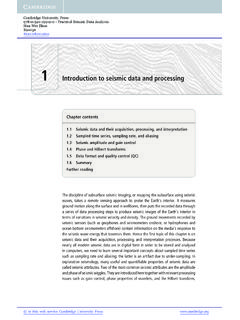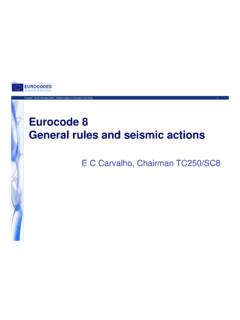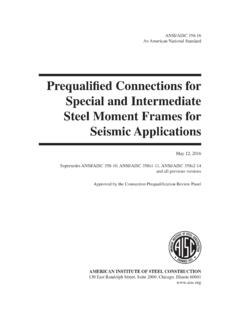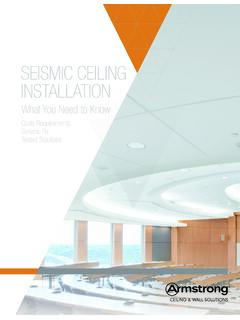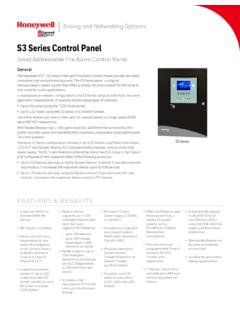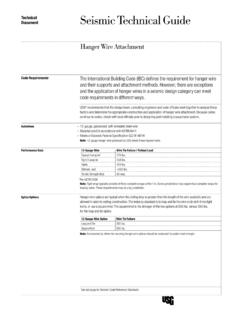Transcription of IBC Table 1604.5 Risk Category
1 The Low Down on Testing and Special Inspection Topics August 2020. IBC Table Risk Category Understanding HOW It Enthusiastically Dry Discussion The arcane Table , Risk Category of Buildings and Other Structures is located in IBC, chapter 16, section and has been located there since the inception of the first International Building Code (IBC) in the year 2000. A copy of the Table can be viewed on page 2. Admittedly, it can be a little tough to take in. Risk categories are assigned to buildings to account for consequences and risks to human life (building occupants) in the event of a building failure. The intent is to assign higher risk categories, and hence higher design criteria, to buildings or structures that, if they experience a failure, would exhibit the availability of essential community services necessary to cope with an emergency situation therefore, have grave consequences to either the building occupants or the population around the building.
2 Section of the IBC building code requires risk categories to be assigned to every building and structure based on descriptions in the nature of occupancy . column in Table The risk Category serves as a threshold for a variety of code provisions related to earthquake, flood, snow, wind loads and even the magnitude of special inspections. Particularly noteworthy are the importance factors that are used in the calculation of design, earthquake, snow and wind loads. The value of the importance factor generally increases with the importance of the facility. Structures assigned greater importance factors must be designed for larger forces.
3 The result is a more robust structure that would be less likely to sustain damage under the same conditions than a structure with a lower importance factor. The intent is to enhance a structure's performance based on its use or need to remain in operation during and after a disaster. The impact of a higher risk Category classification is not limited to increasing the design loads. Compared to Risk Category I, II or III for instance, a Risk Category IV classification can lead to a higher seismic design Category classification that can, in turn, require more stringent seismic detailing and limitations on the seismic -force-resisting system.
4 This can also affect seismic design requirements for architectural, mechanical and electrical components. Got all that? Table Risk Category of Buildings and Other Structures Risk Nature of Occupancy Category Buildings and other structures that represent a low hazard to human life in the event of failure, including but not limited to: Agricultural facilities I Certain temporary facilities Minor storage facilities II Buildings and other structures except those listed in Risk Categories I, III and IV. Buildings and other structures that represent a substantial hazard to human life in the event of failure, including but not limited to: Buildings and other structures whose primary occupancy is public assembly with an occupant load greater than 300.
5 Buildings and other structures containing elementary school, secondary school or day care facili- ties with an occupant load greater than 250. Buidings and other structures containing adult education facilities, such as colleges and universities, with an occupant load greater than 500. Group I-2 occupancies with an occupant load of 50 or more resident care recipients but not having III surgery or emergency treatment facilities. Group I-3 occupancies. Any other occupancy with an occupant load greater than 5000a Power-generating stations, water treatment facilities for potable water, waste water treatment facilities and other public utility facilities not included in Risk Category IV.
6 Buildings and other structures not included in Risk Category IV containing quantities of toxic or explosive materials that: Exceed maximum allowable quantities per control area as given in Table (1) or (2) or per outdoor control area in accordance with the International Fire Code, and Are sufficient to pose a threat to the public if releasedb Buildings and other structures designated as essential facilities, including but not limited to: Group I-2 occupancies having surgery or emergency treatment facilities. Fire, rescue, ambulance and police stations and emergency vehicle garages. Designated earthquake, hurrican or other emergency shelters.
7 Designated emergency preparedness, communications and operations centers and other facilities required for emergency response Power generating stations and other public utility facilities required as emergency back up facili- ties for Risk Category IV structures IV Buildings and other structures containing quantities of highly toxic materials that: Exceed maximum allowable quantities per control area given in Table (2) or per outdoor control area in accordance with the International Fire Code Are sufficient to pose a threat to the public if releasedb Aviation control towers, air traffic control centers and emergency aircraft hangars.
8 Buildings and other structures having critical national defense functions Water storage facilities and pump structures required to maintain water pressure for fire suppression a. For purposes of occupant load calculation, occupancies required by Table to use gross floor area calculations shall be permitted to use net floor areas to determine the total occupant load b. Where approved by the building official, the classification of buildings and other structures as Risk Category III or IV based on their quantities of toxic, highly toxic or explosive materials is permitted to be reduced to Risk Category II, provided it can be demonstrated by a hazard assessment in accordance withSection of ASCE 7 that a release of the toxic, highly toxic or explosive materials is not sufficient to pose a threat to the public.
9 Risk Category IV: These are buildings that are considered to be essential in that their continuous use is needed, particularly in response to disasters. Hospitals, fire stations, police stations and emergency vehicle garages must remain operational during and after major disaster type events. The phrase designated as essential facilities refers to designation by the building official that certain facilities are required for emergency response or disaster recovery. This concept provides jurisdictions the latitude to identify specific facilities that should be considered essential in responding to various types of emergencies.
10 Risk Category III: These buildings include those occupancies that have relatively large numbers of occupants because of the overall size of the building. They also include uses that pose an elevated life-safety hazard to the occupants such as public assembly, schools or colleges. In addition, Risk Category III includes uses where the occupants ability to respond to an emergency is restricted such as jails or otherwise impaired such as nursing homes which house patients who require skilled nursing care. Risk Category III buildings are identified as nonessential by the code and are generally classified (within Risk Category III) based on number of occupants and the use classification according to IBC chapter 3, Occupancy Classification and Use.
